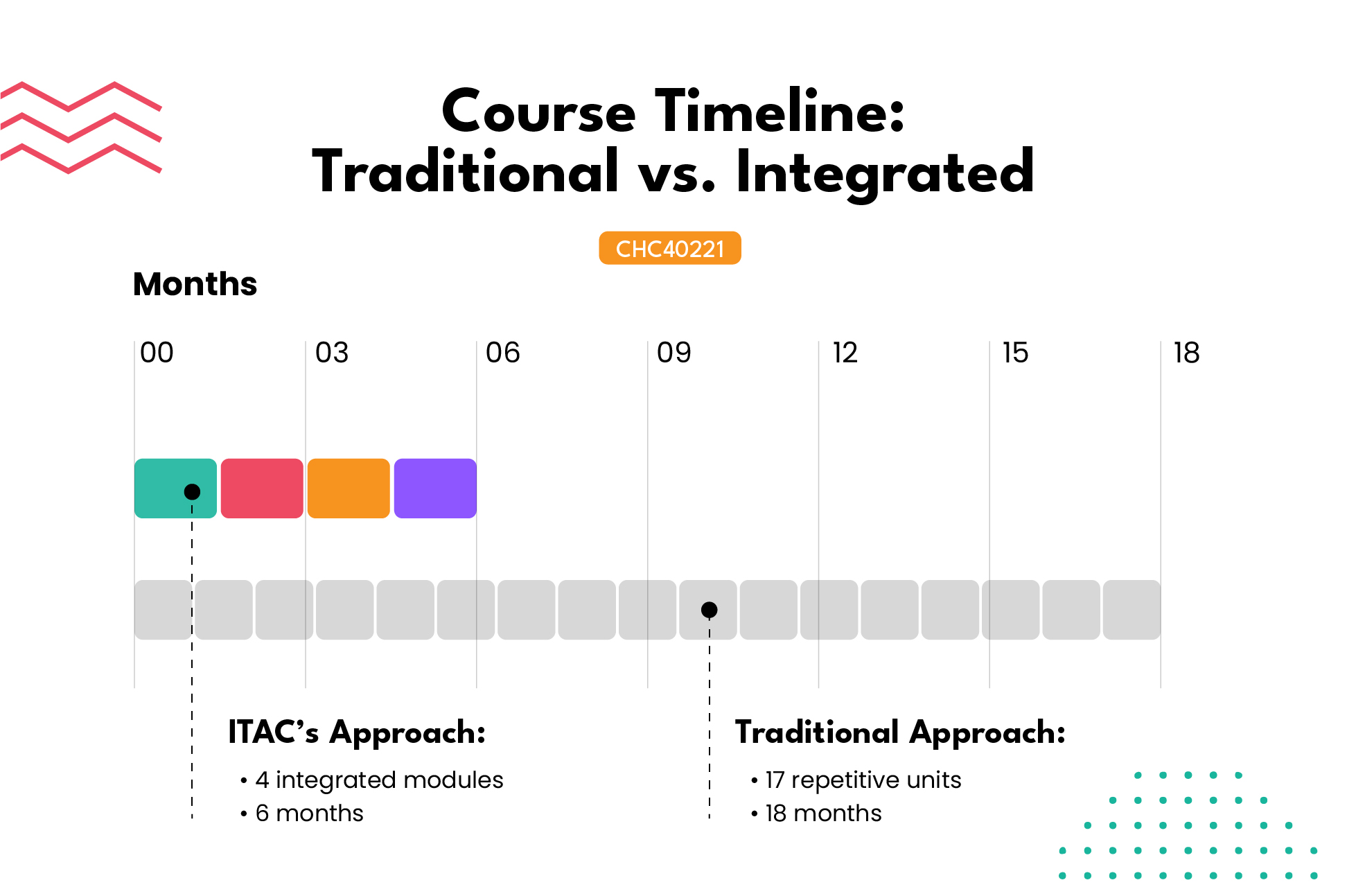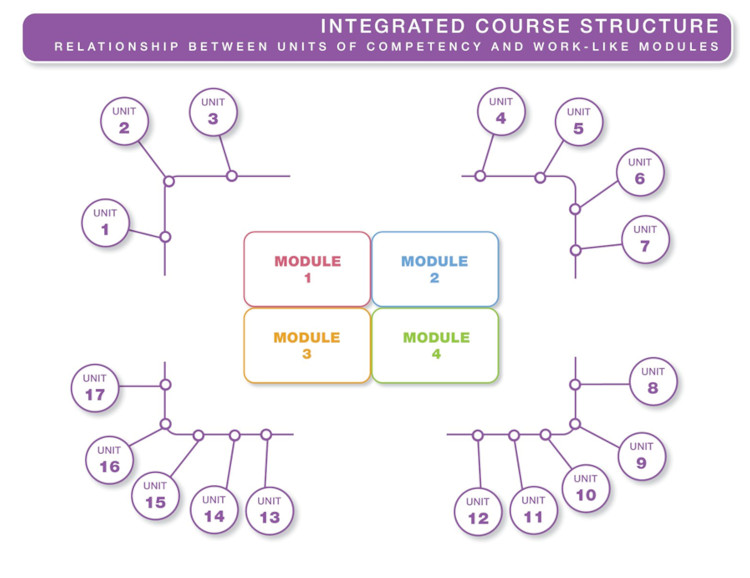
Unlocking Opportunities: Your Guide to Teacher Aide Courses in Victoria

Are you searching for the ideal teacher aide course in Victoria? Victoria's thriving education sector offers an abundance of opportunities for aspiring teacher aides, also known as education support workers, learning support officers and integration aides. With over 2,250 schools across Melbourne, Geelong, Bendigo, and beyond, the demand for skilled teacher aides has never been higher. As a qualified teacher aide in one or more of these Victorian schools, you'll play a vital role in fostering inclusive learning environments where every student can thrive.
In this extensive guide, we'll explore the different teacher aide courses available in Victoria and how they can help you achieve your career goals:
CHC30221 Certificate III in School Based Education Support
- Entry-level teacher aide course that builds foundational knowledge
- Ideal for high school students or those learning English
CHC40221 Certificate IV in School Based Education Support
- More advanced teacher aide course focusing on supporting students with disabilities and additional needs
- Suited for those seeking specialised roles or career progression
- Most adult learners enrol directly into this level or the combo
- Generally, attracts a higher salary if working with students with additional needs
Education Support Combo
- Combines both the Certificate III and IV teacher aide courses in a streamlined program
- Provides a well-rounded skill set for diverse education support roles
- Qualifies teacher aide course graduates to work in every teacher aide role
- Most popular course amongst ITAC students
Diverse Career Pathways for Teacher Aide Course Graduates
Completing a nationally recognised teacher aide course opens doors to a wide array of roles in Victorian schools. You could find yourself:

- Providing general classroom support in primary or secondary settings
- Working one-on-one with students who have additional needs
- Facilitating small group learning activities
- Assisting with the implementation of individual learning plans
- Supporting positive student behaviour and social development
With the practical skills and knowledge gained through your teacher aide course, you'll be well-equipped to make a positive impact in any Victorian school. This article will explain more if you’d like to learn about where a teacher aide course in Victoria could take you.
Practical Placements: Bringing Your Teacher Aide Course to Life
A crucial component of any quality teacher aide course is practical placement experience. During your placement, you'll work closely with experienced teachers and education support staff, honing your skills in a supportive environment.
Our Victoria-based trainers will visit you on-site, offering personalised guidance and feedback to help you excel. Many of our teacher aide course graduates secure employment directly through their placement schools, a testament to the industry relevance of our training and ITAC’s reputation as the leading and largest provider in this area.
The ITAC Advantage: Accelerated Learning, Unparalleled Support
ITAC stands out as Victoria's premier provider of teacher aide courses. Our unique integrated learning approach allows you to complete your teacher aide course up to 18 or more months faster than traditional unit-by-unit programs. By clustering related competencies into practical, work-based modules, we eliminate unnecessary repetition, empowering you to graduate job-ready in as little as 6 months.

When you choose an ITAC teacher aide course, you'll benefit from:
- Flexible online learning that fits your lifestyle – structured, supported and self-paced
- Integrated work-like modules saving months of time – complete in 6 months or less
- Engaging content developed by industry experts – teachers in your local area
- Dedicated support from Victoria-based trainers – friendly trainers just a click or call away
- Valuable placement opportunities in local schools – 100 hours in a local school
- Strong connections with the Victorian education sector – Links with 1000s of schools
Take the First Step Towards Your Dream Career
Whether you're based in metropolitan Melbourne or regional Victoria, a teacher aide course with ITAC is your launchpad to a rewarding career as an LSO in your preferred school. Our courses blend theory with hands-on experience, ensuring you graduate with the capabilities to thrive in any school setting.
Don't wait to start making a difference. Explore our teacher aide courses today and take the first step towards a brighter future for yourself and the students you'll support. Contact our friendly team to discuss which course best aligns with your goals – we're excited to be part of your journey!
Navigating This Article
This detailed guide covers everything about the ITAC’s teacher aide courses available in Victoria.
Quick Links - If you don't need the full article:
- CHC30221 Certificate III in School Based Education Support
- CHC40221 Certificate IV in School Based Education Support
- Education Support Combo - Our Most Popular Option
Key Resources:
Contact Us:
- Phone: 1300 858 191
- Email: info@itac.edu.au
- Contact Page
Below you'll find links to an in-depth exploration of each topic - simply select the area you'd like to learn more about:
Table of Contents
- Briefly, What Do I Need to Know About Teacher Aide Courses in Victoria?
- How Hard Is It to Become a Teacher Aide in Victoria?
- How Much Do Teacher Aides in Victoria Earn?
- Can I Study a Teacher Aide Course Online in Victoria?
- How Does ITAC Structure Their Teacher Aide Courses?
- How Does ITAC's Integrated Course Structure Save Me Time?
- Tell Me About the Placement and What It Involves.
- Discovering the Right Teacher Aide Course for You in Victoria
- Career Pathways for Teacher Aide Course Graduates
- Wrapping Up the Ultimate Guide to Teacher Aide Courses in Victoria: Key Takeaways
Briefly, What Do I Need to Know About Teacher Aide Courses in Victoria?

Too busy to read this entire article? Here are the key points to keep in mind when considering a nationally recognised teacher aide course in Victoria:
- The CHC30221 Certificate III in School Based Education Support is the entry-level teacher aide course in Victoria, primarily designed for high school students or those just starting their working lives.
- For adult learners in Victoria, the CHC40221 Certificate IV in School Based Education Support is often the preferred choice, as it equips you with the skills and knowledge to work with students with disabilities and additional needs, making you a more competitive candidate in the job market.
- ITAC's Education Support Combo is the most sought-after course among students, as it combines both the Certificate III and IV, providing comprehensive training while saving you time and money. ITAC is the only provider offering a genuine 'combo' program, allowing you to complete your course in a shorter timeframe.
- Studying a teacher aide course online in Victoria offers the flexibility and convenience to learn at your own pace. Look for a provider that offers a range of support services, such as live webinars, workplace visits, regular trainer contact, a video library, and custom-developed resources to enhance your learning experience.
- To meet the 100-hour requirement, your work placement will typically span 100 hours or 16 days. Many students secure employment in the school where they complete their placement, highlighting the importance of choosing a reputable, research-based teacher aide course.
- Enrolling in a course that utilises an integrated structure, where units are combined into modules, can save you hundreds of hours of study time. By completing an integrated course, you can earn up to $90,000 by finishing your studies 18 months or more earlier than a unit-by-unit course, and working full-time instead. In an integrated approach, generic content is assessed only once, whereas a unit-by-unit approach may require you to be assessed on the same content for every unit.
- Schools prioritise hiring staff who can implement effective instructional techniques, such as guided and shared learning. ITAC is the only provider that focuses on teaching the best-practice instructional techniques that schools actively seek in their teacher aides and teacher assistants.
- When selecting a teacher aide course, consider factors such as the course structure, the quality of learning materials, the level of support provided, and the institution's reputation within the education sector. Choosing a well-regarded, industry-relevant course can significantly impact your future employment prospects.
By keeping these key points in mind, you can make an informed decision when selecting a teacher aide course in Victoria, setting yourself up for a rewarding career in education support.
Lydia's Leap: From Management to Making a Difference in Melbourne
Lydia, a 35-year-old mother of two from Melbourne's eastern suburbs, had built a successful career in management. However, after her eldest child was diagnosed with global developmental delay, Lydia found herself drawn to the world of education support. Inspired by her own experiences and the desire to help other families, Lydia embarked on a journey to become a teacher aide by enrolling in the CHC40221 Certificate IV in School Based Education Support.
The flexibility of the online teacher aide course allowed Lydia to balance her studies with her family responsibilities and part-time work. Some weeks, she would dedicate up to 30 hours to her coursework, while other times, she could only spare a couple of hours. The self-paced nature of the qualification meant that Lydia could progress through the material at her own speed, taking the time to deeply engage with the content and apply it to real-world scenarios.
Throughout her 6-month teacher aide training, Lydia gained a deep understanding of inclusive education practices, learning strategies, and the importance of fostering a supportive classroom environment. Her personal experiences with her son's learning challenges added a unique perspective to her studies, allowing her to approach her work with empathy and understanding.

Since completing her Certificate IV teacher aide course, Lydia has secured a position at a primary school in Melbourne that prides itself on its inclusive culture. She works closely with students who have diverse learning needs, drawing on the knowledge and skills she gained during her qualification to provide targeted support and encouragement. Lydia's story is a testament to the power of personal experience and the drive to make a positive difference in the lives of young learners.
Jenny's Journey: From Hospitality to Helping Students Thrive in Geelong
Jenny, a 42-year-old former restaurant manager from Geelong, had always found joy in teaching and mentoring young people in the workplace. After years in the fast-paced hospitality industry, Jenny yearned for a career change that would allow her to make a lasting impact on the lives of students while providing a better work-life balance. Inspired by her own children's experiences in primary school, Jenny enrolled in the CHC30221 Certificate III in School Based Education Support.
The online delivery of the teacher aide course allowed Jenny to study around her family commitments, completing the qualification in just 5 months. Jenny immersed herself in learning about child development, behaviour management strategies, and ways to support students with diverse learning styles. She particularly enjoyed exploring creative approaches to teaching, recognising that sometimes thinking "outside the box" can make all the difference in engaging young minds.
During her practical placement, a key component of the Certificate III teacher aide training, Jenny's warm personality and ability to connect with students shone through. She quickly became a valued member of the classroom, working collaboratively with the teacher to create a positive and inclusive learning environment.
Armed with her newfound knowledge and practical experience, Jenny now works as a teacher aide at a primary school in Geelong. She brings her creativity, patience, and understanding to the role, helping to foster a love of learning in her students. Jenny's journey showcases the transferable skills that can be brought from other industries into the rewarding world of education support.
Esperanza's Endeavor: Enhancing Teacher Education in Essendon
Esperanza, a 22-year-old pre-service teacher from Essendon, had always dreamed of working with children. While studying for her Bachelor of Education (Primary), Esperanza recognised the value of gaining practical experience in the classroom. To enhance her understanding of the education system and develop her skills as a future teacher, she enrolled in the CHC30221 Certificate III in School Based Education Support.
Balancing her university studies with the online teacher aide course, Esperanza dedicated between 5 and 15 hours per week to her qualification, completing it within 7 months. The course content complemented her bachelor's degree, providing valuable insights into student support strategies, classroom management techniques, and the importance of fostering positive relationships with students and colleagues.
During her practical placement at a local primary school, Esperanza had the opportunity to work alongside experienced teachers and teacher aides. She gained hands-on experience in supporting students with diverse needs, developing engaging learning activities, and contributing to a positive classroom dynamic.
Esperanza's completion of the Certificate III teacher aide course not only enhanced her practical skills but also demonstrates her commitment to professional development and her passion for education. As she continues her journey towards becoming a qualified primary school teacher, Esperanza's experience as a teacher aide will undoubtedly shape her approach to teaching, allowing her to create inclusive, supportive learning environments that help every student reach their full potential.
By showcasing the diverse backgrounds and motivations of individuals pursuing teacher aide courses in Victoria, we highlight the accessibility and flexibility of these qualifications. Whether you're a career changer, a parent looking to make a difference, or a pre-service teacher seeking to enhance your skills, a teacher aide course like the CHC30221 Certificate III or CHC40221 Certificate IV can provide the knowledge, practical experience, and confidence needed to embark on a fulfilling career in education support.
How Hard Is It to Become a Teacher Aide in Victoria?

Becoming a teacher aide in Victoria is an achievable goal, especially given the current demand for skilled education support professionals across the state. The need for qualified teacher aides is particularly high in several key areas:
- Special needs settings: Demand is very high in special needs settings, where teacher aides play a crucial role in supporting students with additional needs
- High schools: A very high demand for teacher aides to support students' learning and development
- Rural and regional areas of Victoria: The demand for qualified teacher aides is extremely high
- Casual relief teacher aide positions: In very high demand across the state, often leading to more permanent or long-term work opportunities
To set yourself up for success in this field, it's crucial to complete a high quality, research-based, nationally accredited teacher aide course with a reputable provider like ITAC. Our Education Support Combo, which includes both the CHC30221 Certificate III in School Based Education Support and the CHC40221 Certificate IV in School Based Education Support, is the most popular and highly recommended pathway for aspiring teacher aides in Victoria.
Case Study: Meet Naomi
Naomi, a 28-year-old single mother from Melbourne's western suburbs, had always been passionate about working with children and making a difference in her community. Despite having no prior experience in education, she felt a strong calling to pursue a career as a teacher aide. However, like many aspiring education support professionals, Naomi had apprehensions about returning to study and balancing her family responsibilities with her career goals.
After researching various teacher aide courses, Naomi enrolled in ITAC's Education Support Combo, which combines the CHC30221 Certificate III and CHC40221 Certificate IV in School Based Education Support. The flexible online delivery allowed her to study around her family commitments.
For her practical placement, Naomi worked in a primary school, gaining experience across years 1, 2, 3, and 4. This exposure to different classrooms and children helped her develop a diverse skill set and adaptability. She particularly enjoyed working with the year 1 students, helping them develop their early literacy and numeracy skills through engaging, play-based activities.
Almost immediately after graduating, Naomi began working casually. She quickly found herself in high demand, consistently booked for work across several schools in her local area. In fact, within a week of starting casual work, Naomi was offered several ongoing positions, including one at a school just 2 minutes from her home. She gladly accepted this position, thrilled at the prospect of working so close to home.
Naomi's story underscores the high demand for qualified teacher aides in Victoria, especially for those who have completed a course like the Education Support Combo. Having both the Certificate III and IV qualifications gave Naomi an edge when approaching schools for work, as did the strong reputation of ITAC in the education sector.
If you're considering becoming a teacher aide in Victoria, Naomi's experience demonstrates that with the right training and dedication, it's more than possible to turn your passion for working with children into a rewarding and in-demand career. Why not take the first step today and explore the teacher aide courses available through ITAC? With their flexible study options and strong industry connections, you could be well on your way to making a real difference in the lives of students, just like Naomi.
How Much Do Teacher Aides in Victoria Earn?
In Victoria, teacher aides can expect to earn an average of $34 per hour. However, this figure can vary depending on several factors, such as the specific role and years of experience.
Teacher aides in Victoria are paid according to a tiered salary system, where remuneration increases incrementally with each year of service up to a certain point. This structure aims to reward experience, encourage retention, and recognise the growing expertise of education support professionals over time.
Salaries can range from approximately $30 per hour for those just starting out to upwards of $40 per hour for more experienced teacher aides or those in specialised roles. Factors that influence pay rates include:
- Qualifications: Completing a nationally recognised teacher aide course, such as the CHC30221 Certificate III or the more advanced CHC40221 Certificate IV in School Based Education Support, can lead to higher starting salaries and better career prospects.
- Special Needs Support: Teacher aides who work with students with disabilities, disorders, or additional needs often earn more due to the specialised knowledge and skills required to support these students effectively.
- Work Setting: Positions in specialist schools or units catering to students with complex needs usually come with higher pay grades.
- Geographic Location: Some rural or remote schools offer additional financial incentives to attract and retain quality education support staff.
On average, a full-time teacher aide in Victoria working around 32 hours per week can expect to earn approximately $1200 per week before tax.
Investing in a quality teacher aide course from a reputable provider like ITAC can be a game-changer for those seeking to enter or advance in this rewarding field. By gaining the knowledge, skills, and practical experience needed to excel in various education support roles, graduates of these courses can position themselves for success and tap into higher earning potential.
ITAC's courses, including the CHC30221 Certificate III and CHC40221 Certificate IV in School Based Education Support, equip aspiring teacher aides with the tools to make a real difference in students' lives while also boosting their employability and income prospects. With a focus on best-practice strategies, hands-on learning, and adult-friendly support, ITAC is the go-to choice for those looking to build a fulfilling career as a teacher aide in Victoria.
By completing a nationally accredited teacher aide course, you'll open doors to diverse opportunities across the state, from mainstream classrooms to specialist settings, and lay the foundation for a rewarding career with room for professional growth and advancement. Don't settle for less – invest in your future with a top-quality teacher aide qualification from ITAC and start making a real difference in the lives of Victorian students today.
Can I Study a Teacher Aide Course Online in Victoria?

Absolutely! All of ITAC's nationally recognised teacher aide courses, including the popular CHC30221 Certificate III in School Based Education Support and CHC40221 Certificate IV in School Based Education Support, are available online to students across Victoria. This flexible study mode allows you to balance your learning with work, family, and other commitments, while still receiving comprehensive support from our experienced trainers.
When choosing an online teacher aide course, it's essential to look for a provider that offers a range of support services to keep you motivated, on track, and engaged with your learning. At ITAC, we've designed our online courses to provide the perfect blend of flexibility and structure, ensuring you have access to the guidance you need, when you need it.
Our online teacher aide courses feature:
- Weekly live webinars hosted by experienced trainers, where you can connect with classmates, ask questions, and dive deeper into key topics
- Engaging, interactive learning materials developed by education experts, including e-books, videos, and practical activities
- Regular progress check-ins and one-on-one support from your dedicated trainer, who is just a phone call or email away
- Access to our user-friendly online learning platform, where you can complete assessments, track your progress, and access all your course materials 24/7
Investing in your education is one of the wisest decisions you can make for your future, and it's crucial to choose a provider that will set you up for success. At ITAC, our online teacher aide courses are designed and delivered by experienced education professionals who have worked extensively in Victorian schools. We understand the unique needs of adult learners and the specific skills and knowledge that schools look for when hiring teacher aides.
So, if you're ready to take the first step towards a rewarding career as a teacher aide, an online course with ITAC could be the perfect fit for you. With our flexible study options, dedicated support services, and commitment to delivering best-practice training, you'll graduate with the skills, knowledge, and confidence to make a real difference in the lives of students across Victoria.
How Does ITAC Structure Their Teacher Aide Courses?

If you're considering a career as a teacher aide in Victoria, you might be wondering what the learning journey looks like. How are these courses structured to equip you with the knowledge and hands-on skills needed to excel in this rewarding field? Let's explore the key components that make up a well-designed teacher aide course, giving you a clearer picture of what to expect as you embark on this exciting educational path.
Engaging Theoretical Learning from the Comfort of Home
A significant portion of your teacher aide course is delivered through structured online learning, designed to provide you with a solid foundation of knowledge and understanding. This theory component is carefully crafted to be engaging, interactive, and accessible to all learner types, allowing you to progress at your own pace while still benefiting from the support and guidance of experienced trainers.
When you begin your teacher aide course, you'll dive into a range of learning activities that bring the content to life:
- Practical learner guides: These carefully developed resources serve as your primary reference materials, presenting key concepts, strategies, and real-world examples in an easy-to-understand format.
- Immersive e-learning modules: Interactive online modules offer a dynamic and engaging way to explore course content. Expect multimedia elements, quizzes, and practical scenarios that reinforce your understanding and keep you motivated.
- Extensive lecture library: Access a wealth of pre-recorded video lectures delivered by industry experts. These bite-sized lessons allow you to learn at your own pace, revisiting complex topics as needed to cement your knowledge.
- Live weekly webinars: Engage in real-time with trainers and fellow students through regular live online sessions. These interactive webinars provide opportunities to ask questions, discuss case studies, and collaborate on group activities, fostering a supportive learning community.
- Practical at-home activities: Apply your theoretical understanding through a range of hands-on tasks and projects designed to simulate real-world scenarios you'll encounter as a teacher aide. These activities help bridge the gap between theory and practice, preparing you for your future role.
Throughout the theory component of your teacher aide course, you'll have access to a user-friendly online learning platform that serves as your central hub for accessing resources, submitting assessments, tracking your progress, and connecting with trainers and peers. This platform ensures a seamless and organised learning experience, enabling you to focus on mastering the essential knowledge and skills needed to excel as a teacher aide in Victoria.
By combining self-paced study with structured support and collaboration opportunities, the theoretical learning component of your teacher aide course provides a robust foundation for your practical placement and future career. You'll graduate with a deep understanding of key concepts, evidence-based strategies, and best practices in education support, ready to make a positive impact in Victorian classrooms.
Practical, Relevant Assessments to Demonstrate Your Knowledge
As you progress through the theoretical components of your teacher aide course, you'll encounter a range of assessment activities designed to evaluate your understanding and ability to apply key concepts. These assessments are carefully crafted to be practical, relevant, and closely aligned with the real-world tasks you'll encounter as a teacher aide in Victorian schools.
One of the most important things to note is that you won't find any traditional essays, tests, or exams in your teacher aide course. Instead, your knowledge will be assessed through a variety of engaging, skills-based activities that mirror the day-to-day responsibilities of an education support professional.
Expect to encounter the following types of assessment tasks throughout your teacher aide course:
- Short answer questions: These targeted questions will assess your understanding of crucial concepts, strategies, and best practice examples covered in the course materials. You'll provide concise, well-reasoned responses to scenarios and prompts drawn from real classroom situations.
- Video presentations: In some instances, you'll be asked to create short video presentations showcasing your ability to explain key ideas or demonstrate specific skills. This assessment format allows you to develop your communication and presentation abilities, which are essential for collaborating with colleagues and supporting student learning.
- Knowledge verification activities: Throughout the course, you'll complete a series of quizzes and knowledge checks designed to reinforce your understanding of foundational concepts. These activities provide immediate feedback, helping you identify areas where you may need to dedicate more study time.
- Creative projects: At times, you'll be challenged to develop learning resources, visual aids, or other educational materials that support student engagement and understanding. These creative projects allow you to showcase your innovation and resourcefulness while building a portfolio of practical tools you can use in your future role.
The theory assessments in your teacher aide course are carefully designed to evaluate your understanding of the key concepts, strategies, and best practices covered in the learning materials. These assessments aim to ensure you have the necessary background knowledge and a solid foundation to build upon as you progress to the practical placement component of the course.
Immersive Practical Placement in a Victorian School
Once you have successfully completed the theoretical components of your teacher aide course, you'll embark on a transformative practical placement experience. This immersive component requires you to complete a minimum of 100 hours in a registered Victorian school, working alongside experienced teachers and education support staff in a real classroom setting.
Throughout your placement, you'll have the opportunity to apply the knowledge and strategies you've learned in the course, supporting students across a range of learning activities and classroom situations. You'll work closely with your supervising teacher to develop your skills in areas such as:
- Implementing behaviour management strategies
- Supporting students with additional learning needs
- Assisting with small group and individual instruction
- Creating inclusive and engaging learning environments
- Collaborating with educational teams to support student progress
As you navigate the daily challenges and opportunities of working in a school, you'll compile a portfolio of evidence showcasing your growth and achievements. This portfolio will serve as a powerful testament to your developing skills and readiness to work as a teacher aide in Victorian classrooms.
Towards the end of your placement, you'll participate in a workplace observation, where a friendly and supportive trainer from ITAC will visit you on-site. This observation is an opportunity for you to demonstrate your skills in action, receive constructive feedback, and identify any areas where you may need additional support or guidance before graduation.
The Advantages of an Integrated Course Structure

While the learning journey outlined above forms the backbone of ITAC’s teacher aide courses in Victoria, it's important to note that not all providers structure their programs in the same way. Most institutions may opt for a more traditional, unit-by-unit approach, where each competency is taught and assessed separately. However, this method can often lead to significant repetition and a longer overall course duration – in fact, you could end up studying for up to 18 months longer!
In contrast, ITAC's innovative integrated course structure is designed to streamline your learning experience, helping you acquire the necessary skills and knowledge more efficiently. By combining related units into cohesive, work-like modules, ITAC eliminates the redundancies inherent in unit-by-unit delivery. Simply said, this means 3 or 4 practical modules over 6 months or less, compared to 15-17 (up to 32 in a combo) taking 4-6 weeks per unit.
The time and cost savings associated with ITAC's integrated approach are substantial. This accelerated timeline translates into significant financial benefits – you'll be earning a full salary months earlier than your peers, potentially accumulating thousands of extra dollars over the course of your career (up to $90,0000 more in some instances). Plus, you'll reduce expenses like childcare and transportation that can add up during an extended study period.
Embarking on a Transformative Learning Journey
Enrolling in a well-structured teacher aide course is the first step towards a fulfilling career supporting the learning and growth of students across Victoria. By combining engaging theoretical content, practical skill-building assessments, and an immersive placement experience, a quality program will equip you with the tools and confidence needed to excel in this rewarding field.
Choosing a course provider like ITAC ensures you'll receive the guidance, support, and industry-relevant training needed to thrive as a teacher aide across any of Victoria’s many schools. With the right education, mindset, and study routine, you'll emerge as a confident, capable teacher aide ready to make a real impact on the lives of Victorian children.
How Does ITAC's Integrated Course Structure Save Me Time?
If you're considering studying a teacher aide course in Victoria, you may be wondering how the course duration affects your learning experience and career prospects. Most providers deliver their courses over 12 to 24 months, with each unit taught separately. However, ITAC has developed an innovative integrated learning approach that allows students to complete their qualification in as little as 6 months. In this section, we'll explore how ITAC's unique course structure streamlines your learning journey without compromising on the depth or quality of your education, enabling you to enter the workforce as a confident and capable teacher aide in record time.
Accelerated Learning Saves Valuable Time
ITAC's integrated course structure is designed to save you a substantial amount of time compared to traditional unit-by-unit delivery methods. By combining related units into practical, work-based modules, ITAC eliminates the redundancies and repetition often found in teacher aide courses. This means you can complete your qualification in as little as 6 months, rather than the 12-24 months required by most other providers, without sacrificing the depth or quality of your learning.
Earn Up to $90,000 More by Entering the Workforce Sooner
Completing your teacher aide course faster not only saves you time but also translates into significant financial gains. By graduating and entering the workforce up to 18 months earlier, you can potentially earn up to $90,000 more than your peers studying in longer programs. This additional income can make a substantial difference in your life, allowing you to achieve your financial goals sooner and enjoy greater career stability.
Higher Completion Rates Mean a Better Chance of Success
Integrated learning models, like the one employed by ITAC, have been shown to result in higher completion rates compared to traditional unit-by-unit courses. The engaging, work-relevant content and the streamlined structure of the course keep students motivated and focused, reducing the likelihood of boredom, frustration, or dropping out. By choosing ITAC's integrated teacher aide course, you're not only investing in your education but also increasing your chances of successfully completing your qualification and achieving your career goals.
Less Time Studying Means More Time for What Matters Most
Studying for a shorter period means you'll have more time to dedicate to the things that matter most to you, like family, friends, and personal interests. ITAC's 6-month course duration allows you to maintain a healthier work-life balance, ensuring that you can pursue your career goals without sacrificing your personal life. Additionally, a shorter study period means less money spent on expenses like travel to classes and childcare, allowing you to allocate your resources more effectively.
Engaging Materials Lead to Better Learning Outcomes
ITAC's integrated course structure not only saves time but also promotes better learning outcomes. The engaging, work-relevant content keeps students interested and motivated, leading to higher retention of information and the development of practical skills. By studying in a more engaging and efficient manner, you'll likely graduate with a deeper understanding of the teacher aide role and be better prepared to apply your knowledge in real-world settings.
Develop Work-Ready Skills from Day One

In a real classroom setting, teacher aides rarely perform tasks that draw from just one unit of competency. Instead, they often need to apply knowledge and skills from multiple areas simultaneously, such as supporting literacy while managing behaviour and collecting data. ITAC's integrated course structure mirrors this reality by combining related units into work-like modules, allowing you to develop the practical, multi-faceted skills you'll need to succeed as a teacher aide from the very beginning of your studies.
ITAC: The Smarter Choice
In summary, ITAC's innovative integrated learning approach offers numerous advantages for students pursuing a teacher aide course in Victoria. By combining related units into practical, work-based modules, ITAC streamlines the learning process, allowing students to complete their qualification in as little as 6 months. This accelerated timeline translates into significant financial benefits, with graduates potentially earning up to $90,000 more than their peers in longer programs.
The engaging, work-relevant content not only keeps students motivated but also leads to better learning outcomes and the development of practical, job-ready skills from day one. Moreover, the shorter study duration means students have more time for family, friends, and personal interests while also reducing expenses associated with travel and childcare.
With its unique course structure, high completion rates, and commitment to delivering industry-relevant training, ITAC emerges as the clear choice for aspiring teacher aides in Victoria seeking a smarter, faster path to a rewarding career in education support.
Amalia's Adventure: From Chef to Classroom Support
Amalia, a 40-year-old chef and mother of two from Melbourne's bustling inner-city, had spent the last two decades whipping up culinary delights. But as the years went by, she found herself craving a change of pace, a new challenge that would allow her to make a difference in the lives of young people.
With her children growing up and her priorities shifting, Amalia began to explore the idea of becoming a teacher aide. She knew it would be a significant shift from the fast-paced world of professional kitchens, but something about working in a classroom, supporting students as they learned and grew, just felt right.
Amalia's busy schedule made traditional study options seem daunting. That's when she discovered ITAC's Education Support Combo, an online teacher aide course that would allow her to earn both the CHC30221 Certificate III and CHC40221 Certificate IV in School Based Education Support at her own pace.
As Amalia immersed herself in the teacher aide course material, she found herself captivated by the engaging content and the practical skills she was developing. The self-paced nature of the program meant she could dedicate time to her studies whenever her schedule allowed.
The 100-hour practical placement, a key component of Amalia’s teacher aide course, was a turning point for her. Working alongside experienced teachers and teacher aides, she had the opportunity to apply her newfound knowledge in a real classroom setting. It was during this time that Amalia truly realised the impact she could have as a teacher aide in her local community.
Just one month after completing her teacher aide qualifications, Amalia landed a full-time position at a local primary school. Now, instead of dicing vegetables and searing steaks, she spends her days working with a lively group of Year 2 students, supporting their learning and growth. While the culinary world will always hold a special place in her heart, Amalia knows she's finally found her true calling – plus, no more evening or weekend work!
Isabella's Journey: From British Design to Aussie Education Support
At just 25 years old, Isabella had already accumulated an impressive array of qualifications and experiences. With an Honours degree in Design from a prestigious UK university, multiple fitness certifications, and training in various massage techniques, she was a true jack-of-all-trades.
But Isabella was ready for a new adventure. She decided to make the bold move to Melbourne, eager to embrace the laid-back Aussie lifestyle and explore new career opportunities. While her ultimate goal was to start her own photography and sports coaching business, Isabella knew she needed a stable part-time job to support herself as she settled into her new home.
As she researched her options, the role of a teacher aide caught Isabella's eye. It seemed like the perfect way to make a meaningful difference in the lives of young students while putting her diverse skill set to good use. Plus, the stable income would give her the financial freedom to pursue her entrepreneurial dreams on the side.
Isabella enrolled in ITAC's Education Support Combo, an online teacher aide course that would allow her to earn her CHC30221 Certificate III and CHC40221 Certificate IV in School Based Education Support. The flexibility of the program was a huge drawcard, allowing her to study at her own pace as she navigated the challenges of starting a new life in a foreign country.
From the very first module of the teacher aide course, Isabella was hooked. The engaging content and the support of her dedicated trainer made the learning experience both enjoyable and rewarding. She found herself eagerly applying the concepts she learned to real-world scenarios, brainstorming creative ways to support students with diverse learning needs.
Soon after completing her teacher aide qualifications with ITAC, Isabella secured a part-time position at the same school where she completed her placement. Now, she spends her days supporting students' learning, drawing on her background in design and sports to create engaging lessons and activities.
Tell Me About the Placement and What It Involves.

The 100-hour practical placement is a crucial component of all teacher aide courses in Victoria. It's your opportunity to put your newfound knowledge and skills into practice in a real school setting, working alongside experienced educators to support student learning. While the idea of stepping into a classroom for the first time may seem daunting, remember that this is a learning experience designed to help you grow and develop as an education support professional.
What to Expect During Your Teacher Aide Course Placement
During your placement, which is typically spread out over 16 days at 1-5 days per week, you'll have the chance to:
- Assist with the delivery of learning activities and content
- Support individual students or small groups
- Help manage classroom behaviour and create a positive learning environment
- Develop and adapt learning resources under the guidance of your supervising teacher
- Provide administrative and logistical support to the teaching team
Throughout your 100 hours, you'll compile a portfolio of evidence showcasing your developing skills and reflecting on your experiences. This portfolio, along with feedback from your supervising teacher, will form a key part of your assessment for your teacher aide course.
The Benefits of a Structured Placement Experience
While it's natural to feel some nerves about your placement, remember that this is an invaluable opportunity to:
- Gain practical, hands-on experience in a supportive environment
- Observe and learn from experienced teachers and teacher aides
- Build your confidence in working with students of different ages, abilities, and backgrounds
- Develop professional relationships within the school community
- Put your theoretical learning into practice and refine your skills
- Confirm your passion for working in education and supporting student learning
One of the key advantages of choosing a reputable provider like ITAC for your teacher aide course is the structured support you'll receive during your placement. An ITAC trainer will visit you on-site towards the end of your 100 hours to observe your practice, provide valuable feedback, and ensure you're on track to successfully complete your qualification. This visit is also an opportunity to showcase your skills to your placement school, potentially opening doors for future employment.
The Importance of Choosing the Right Teacher Aide Course Provider
When selecting a provider for your teacher aide training in Victoria, it's essential to consider the level of support and guidance they offer during your placement. Look for a provider that:
- Has strong partnerships with schools across Victoria, including your local area
- Provides clear guidance and resources to help you navigate your placement with confidence
- Offers personalised support from experienced trainers who understand the realities of working in Victorian schools
- Includes a structured on-site visit as part of your assessment, giving you the opportunity to demonstrate your skills and receive targeted feedback
Remember, while the placement may seem challenging at first, it's an exciting opportunity to grow, learn, and make a real difference in the lives of students. Embrace the experience, seek out feedback and guidance, and know that with each day, you're building the skills and confidence to thrive in your future role as an education support professional in Victoria's diverse school communities.
Discovering the Right Teacher Aide Course for You in Victoria

When choosing a teacher aide course in Victoria, it's crucial to understand the key differences between the available qualifications and how they align with your career goals. In this section, we'll explore the unique focus areas and outcomes of the CHC30221 Certificate III in School Based Education Support, the CHC40221 Certificate IV in School Based Education Support, and the popular Education Support Combo. By gaining a clear understanding of what you'll learn in each course and the types of roles they prepare you for, you'll be well-equipped to make an informed decision about your study path.
Exploring the Different Levels of Teacher Aide Courses
When considering a teacher aide course in Victoria, it's important to understand the distinctions between the two main qualification levels: the CHC30221 Certificate III in School Based Education Support and the CHC40221 Certificate IV in School Based Education Support.
The CHC30221 Certificate III in School Based Education Support is the entry-level qualification for those seeking to work as teacher aides in Victorian schools. This course covers the fundamental skills and knowledge needed to provide general support in mainstream classrooms, such as assisting with lesson preparation, supervising group activities, and helping students with basic literacy and numeracy tasks. While the Certificate III is a valuable starting point, it's important to note that it may not be the best choice for all aspiring teacher aides.
For most adult learners in Victoria, the CHC40221 Certificate IV in School Based Education Support is the preferred pathway. This higher-level teacher aide course focuses on the skills and strategies needed to support students with additional needs, such as autism spectrum disorder, developmental delays, or other learning challenges. With over 90% of teacher aide roles in Victoria focusing on providing this type of specialised support, the Certificate IV is the ideal qualification for those seeking to maximise their job opportunities and make a meaningful difference in diverse classroom settings.
It's important to understand that the Certificate IV is not a highly specialised course like many believe, but rather builds upon the foundational skills covered in the Certificate III. For example, when learning about behaviour management techniques, Certificate IV students will explore how these strategies can be adapted to support students with autism, taking into account common characteristics of autism such as repetitive behaviours and the importance of visual routines.
Combining Qualifications with the Education Support Combo
For aspiring teacher aides who want to gain the most comprehensive skill set and stand out to potential employers, ITAC's Education Support Combo is the smart choice. This innovative program combines both the CHC30221 Certificate III and the CHC40221 Certificate IV in School Based Education Support into a single, streamlined course.
By studying the Education Support Combo, you'll save significant time and money compared to completing the two qualifications separately. In fact, learners who choose this pathway could finish their training up to 18 months sooner, allowing them to enter the workforce and start earning a full teacher aide salary much earlier. By working those 18 months instead of studying two teacher aide courses, this accelerated timeline could translate to $90,000 or more in additional income.
The efficiency of the Education Support Combo lies in its integrated approach to training. Rather than repeating similar content across the 32 units that make up the Certificate III and IV, the combo program identifies common themes and consolidates learning into cohesive, practical modules. This eliminates redundancy and allows you to develop a well-rounded skill set in a shorter timeframe, without compromising on the depth or quality of your learning.
It's no surprise that the Education Support Combo is ITAC's most popular teacher aide course in Victoria, with the vast majority of students opting for this cost-effective, resume-boosting pathway. By dedicating just 5-10% more time than a single qualification, you'll graduate with a versatile skill set that opens doors to a wide range of roles in Victorian schools, from mainstream classrooms to specialist support settings.
Weighing Your Options: Certificate III, Certificate IV, or Education Support Combo?
When it comes to selecting the best teacher aide course for your needs and goals, it's essential to consider the unique benefits and outcomes of each qualification. In Victoria, aspiring teacher aides can choose between:
- CHC30221 Certificate III in School Based Education Support
- CHC40221 Certificate IV in School Based Education Support
- ITAC's popular Education Support Combo
For the vast majority of students, we highly recommend the Education Support Combo as the most in-depth and valuable pathway. This innovative program offers several key advantages:
- Combines both the Certificate III and IV into a single, streamlined course
- Equips you with a diverse skill set for the widest range of roles in Victorian schools
- Ensures you're prepared for any education support position, as some schools may prefer the Certificate III for certain roles, while others require the more advanced Certificate IV
If you're not ready to commit to the Education Support Combo, the CHC40221 Certificate IV in School Based Education Support is the next best choice for most adult learners. Here's why:
- Over 90% of teacher aide positions in Victoria focus on supporting students with disabilities, learning difficulties, or other additional needs (and this is not a topic in the Certificate III)
- Provides the specialised skills and knowledge to excel in these high-demand roles
- Has become the standard qualification sought by most Victorian schools in today's inclusive education landscape
The CHC30221 Certificate III in School Based Education Support is generally recommended for individuals who may:
- Lack confidence in their learning abilities
- Have specific language or learning needs
- Be high school students exploring career options
- Be migrants who are still developing their English language skills
- Have learning disorders and need a supportive training environment
Ultimately, the best teacher aide course for you will depend on your unique circumstances, career aspirations, and learning styles. If you're unsure about which qualification aligns best with your goals, ITAC's friendly and experienced team is always happy to discuss your situation and provide personalised guidance. With our flexible study options, Victorian-based trainers, and commitment to your success, you can feel confident in taking the first step towards a rewarding career supporting students in Victoria's diverse school settings.
Holly's Head Start: Pursuing a Teacher Aide Course in High School

Holly, a Year 11 student in Melbourne, has always admired her parents' dedication to their teaching careers. Inspired by their passion for education, she decided to start her own journey towards becoming a teacher aide by enrolling in the CHC30221 Certificate III in School Based Education Support.
With the encouragement of her teachers and the guidance of her parents, Holly plans to complete the course over two years alongside her high school studies. She dedicates a couple of hours each week to working on her teacher aide course modules, gaining a solid foundation in supporting student learning and well-being.
"I love how the Certificate III is giving me practical skills I can use when I volunteer in the junior classes," Holly shared. "It's also helping me understand the behind-the-scenes work that goes into creating a great learning environment."
For Holly, pursuing a teacher aide course in high school is not only a way to explore her career aspirations but also an opportunity to develop valuable skills that will serve her well in any future path. "Even if I decide to go into a different field, I know the communication, organisation, and problem-solving skills I'm gaining will be useful," she reflected.
Maryann's Transition: From Early Childhood to Education Support
Maryann, a mother of three from Bendigo, had built a successful career in early childhood education. However, as her own children grew older, she found herself seeking a change that would allow her to better align her work schedule with her family's needs.
With a CHC30213 Certificate III in Education Support already under her belt from several years ago, Maryann knew that upskilling with a CHC40221 Certificate IV in School Based Education Support was the logical next step. "I wanted to work with children as I feel that’s an area I have heaps of experience in, but also work with children with additional needs as I have a child with autism and I feel I have a lot to offer,” she explained.
Maryann's decision to transition into education support has been a positive one for her family. She was thrilled to secure a position at her children's school, although she won't be directly working in their classrooms to maintain professional boundaries. "It's wonderful to be part of the same school community as my kids," she shared.
Through her teacher aide course, Maryann has gained a deeper understanding of inclusive education practices and strategies for fostering positive learning environments. She's excited to apply her skills and make a difference in the lives of the students she supports in her new role.
Adrian's New Adventure After the Education Support Combo
After years of working in the challenging youth sector, 41-year-old Adrian from Geelong found himself at a crossroads. While he loved making a difference in young people's lives, he recognised that he needed a change to sustain his passion for helping others.
Inspired by his volunteer work with a local high school outreach program, which combined his love for cars and the outdoors with mentoring students, Adrian decided to pursue a career as an education support professional. He enrolled in ITAC's Education Support Combo, appreciating the flexibility of online study and the opportunity to gain a diverse skill set.
"The combo felt like the perfect fit for me," Adrian shared. "I knew I wanted to work with students across different age groups and settings, and gaining both the Certificate III and IV would give me that versatility."
Throughout his teacher aide course, Adrian was particularly impressed by the support and guidance provided by ITAC's experienced trainers. During his practical placement, his trainer's visit and feedback on his instructional delivery not only boosted his confidence but also caught the attention of the school leadership team.
"I think that extra level of support really made a difference," Adrian reflected. "It showed the school that I was serious about developing my skills and being the best at what I do."
Now working with Years 10-12 in the school's outreach program, Adrian is thriving in his new role. He's grateful for the solid foundation his teacher aide course has provided and looks forward to the opportunities it will open up in the future, including the possibility of working with primary school students one to “mix it up a bit.”
For Adrian, becoming an education support professional has been a transformative journey. "It's given me a renewed sense of purpose and a way to make a positive impact, and I love working in teams – it feels good every morning," he shared. "Thoroughly recommend the Combo."
Career Pathways for Teacher Aide Course Graduates

As a qualified teacher aide in Victoria, you'll find yourself in high demand across the state's thriving education sector. With over 2,250 schools spanning metropolitan Melbourne to regional centres like Geelong, Ballarat and Bendigo, opportunities abound for those passionate about supporting student learning and wellbeing. Let's explore the range of roles and settings where your skills will be valued:
Supporting Students in Mainstream Classrooms
Many teacher aide course graduates begin their careers working alongside teachers in mainstream primary and secondary classrooms. In these inclusive environments, you might:
- Provide one-on-one or small group support to students who need extra assistance with literacy, numeracy or other subject areas
- Help implement differentiated learning activities to cater to students' individual needs and learning styles
- Support the integration of students with disabilities or additional needs into mainstream classes
- Assist with classroom management and behaviour support strategies to promote a positive learning environment
By applying the knowledge gained in your teacher aide course, you'll play a vital role in ensuring every student can access the curriculum and thrive academically and socially.
Making a Difference in Specialist Schools
For those drawn to supporting students with more complex needs, Victoria's 80+ specialist schools offer incredibly rewarding career pathways. These purpose-built environments cater specifically to students with moderate to severe intellectual disabilities, physical disabilities, autism spectrum disorder, or multiple disabilities.
As a teacher aide in a specialist school setting, you'll work as part of a multidisciplinary team to:
- Implement individualised learning plans tailored to each student's unique strengths and needs
- Facilitate the development of life skills, social skills, and communication skills through structured programs
- Assist with personal care needs such as toileting, feeding and mobility support
- Support the use of assistive technologies, alternative communication methods and sensory aids
- Help create a safe, supportive and engaging learning environment that celebrates diversity
With the specialised strategies learned in your teacher aide course at the Certificate IV level, you'll be well-equipped to empower students with disabilities to participate fully in their education and reach their potential.
Providing Targeted Support in Specialist Units and Support Programs
In addition to dedicated specialist schools, many mainstream schools have specialist facilities or targeted support programs for students with specific learning needs. These might include:
- Autism Spectrum Disorder (ASD) support hubs
- Personalised learning programs for students with dyslexia or dyscalculia
- English as an Additional Language (EAL) support programs
- Literacy or numeracy intervention groups
- Behaviour support or engagement programs
Working within these specialised programs, you'll implement evidence-based strategies to scaffold learning, build core skills, and foster a sense of belonging for students who may struggle in traditional classroom settings. This often involves working closely with small groups or individual students to provide intensive, targeted support aligned with their specific learning goals.
Championing Inclusion in Victorian Schools
Across all Victorian school settings, there is a strong focus on inclusive education – ensuring that students with disabilities, additional needs or diverse backgrounds have equitable access to learning opportunities. As a graduate of ITAC’s highly regarded teacher aide course, you'll be at the forefront of implementing inclusive practices in classrooms and school communities.
This might involve:
- Collaborating with teachers to adapt lesson plans, assessments and resources to cater for all learners
- Advocating for reasonable adjustments to support the full participation of students with disabilities
- Modelling the use of inclusive language and promoting understanding of diversity among students
- Supporting the social inclusion of students with additional needs during class activities and break times
- Contributing to a positive school culture where every student feels valued, respected and supported
By championing inclusion, you'll help create learning environments where every student can flourish academically, socially and emotionally.
Family-Friendly Working Hours
One of the major drawcards of a career as a teacher aide in Victoria is the family-friendly working hours. With most roles following school hours (approximately 8:30am to 3:30pm), you'll have evenings and weekends free to spend with loved ones. You'll also enjoy generous school holiday periods, with around 12 weeks of paid leave per year – perfect for quality family time or personal pursuits.
This work schedule is particularly appealing for parents looking to balance career aspirations with family commitments. Many teacher aides appreciate the ability to work during school terms, allowing them to be present for their own children before and after school without needing additional childcare arrangements.
For those seeking greater flexibility, part-time or job-share arrangements are often available. This can be ideal for return-to-work parents, those with carer responsibilities, or individuals looking to pursue further study alongside their role. With schools in nearly every community across Victoria, you're likely to find opportunities close to home that align with your preferred working pattern.
Competitive Salaries and Career Progression
As a qualified teacher aide in Victoria, you can expect to earn a competitive salary that recognises your skills and experience. Current school awards indicate pay rates of approximately $30-$40 per hour, depending on your qualification level and responsibilities. This equates to an average full-time salary in the range of $56,000 to $72,000 annually.
Teacher aide salaries in Victorian schools are paid according to an incremental scale, with pay increases based on years of service and professional development. This structure rewards your growing expertise and commitment to the role over time. Those who undertake additional training, such as specialised support strategies or sign language skills, can often access higher pay grades.
The CHC40221 Certificate IV in School Based Education Support is particularly valued by employers, as it equips you with advanced skills to support students with disabilities, challenging behaviours or complex needs. Graduates of this higher-level course are well-positioned to take on more specialised roles with greater responsibilities and remuneration.
With strong industry demand, competitive pay rates, and diverse opportunities for professional growth, a career as a teacher aide in Victoria offers a rewarding pathway for those passionate about making a difference in students' lives.
Taking the First Steps Towards Your New Career
If you're inspired by the opportunity to support Victorian students to thrive academically, socially and emotionally, a nationally accredited teacher aide course is your launchpad into this fulfilling career path. Whether you're drawn to mainstream classroom support, specialist education settings or inclusive learning programs, the skills and knowledge you'll gain will be highly valued by schools across the state.
As Victoria's leading provider of teacher aide courses, ITAC offers flexible online qualifications designed to equip you with the practical capabilities employers are seeking. Our experienced trainers provide comprehensive support at every stage of your learning journey, while our extensive network of school partners open doors to exciting placement and employment opportunities.
So why wait to start making a difference? Explore Australia’s most popular teacher aide courses today and take the first steps towards a rewarding career supporting diverse learners to reach their full potential. With the right qualification and a passion for inclusive education, you'll be well on your way to securing your dream role in Victoria's world-class school system.
Wrapping Up the Ultimate Guide to Teacher Aide Courses in Victoria: Key Takeaways
Becoming a Teacher Aide in Victoria: Your Path to a Rewarding Career

Congratulations on making it through this comprehensive guide to becoming a teacher aide in Victoria! Let's take a moment to reflect on the key insights you've gained and how they'll shape your journey into this fulfilling profession.
The Importance of Quality Training
One of the most crucial takeaways is the significance of completing a reputable teacher aide course. While becoming a teacher aide is relatively straightforward, the quality of your training will directly impact your success in the classroom and your employability.
Investing in a program that equips you with best-practice strategies – such as explicit teaching, cooperative learning, and metacognitive skills – will set you apart from the crowd. As you explore course options, don't hesitate to ask providers as many questions as you need answered – enrolling in an accredited course is a big commitment.
Choosing the Right Qualification Level
Another key consideration is the qualification level that aligns with your career goals. The CHC30221 Certificate III in School Based Education Support provides a solid foundation for working as a teacher aide in Victoria, covering all the essentials you need to support student learning.
However, if you aspire to take on additional responsibilities or specialise in areas that attract a higher salary and more independence, then the CHC40221 Certificate IV in School Based Education Support or the very popular Education Support Combo are smart choices. Both of these options often translate to increased job opportunities and earning potential.
The Benefits of an Integrated Learning Approach
As you compare training providers, pay close attention to the course structure and delivery method. Opting for a program with an integrated learning approach – where units are combined into practical, work-like modules – can save you hundreds of hours of unnecessary assessments, stress and lost income.
ITAC’s revolutionary and efficient model allows you to gain the same valuable skills and knowledge in a condensed timeframe, meaning you can launch your teacher aide career and start making a difference sooner. You could earn up to $90,000 more compared to enrolling elsewhere and taking 18 months longer.
Good Pay in a High-Demand and Reputable Profession
Teacher aides in Victoria are in high demand, reflecting the growing recognition of their essential role in supporting students and teachers in schools. With an increasing focus on inclusive education and tailored support for students with diverse needs, the demand for skilled teacher aides continues to rise. This creates excellent short and long-term opportunities for individuals considering a career in education support.
In terms of remuneration, teacher aides in Victoria typically earn between $30 and $40 per hour. Pay rates are determined by set pay scales, which increase incrementally based on years of service. These predictable pay structures provide stability and a clear pathway for financial growth over time.
This combination of strong demand, meaningful work, and competitive pay makes becoming a teacher aide in Victoria an attractive career path for those passionate about education and student support.
Embracing a Life-Changing Career
Becoming a teacher aide is more than just a smart career move – it's an opportunity to make a profound impact on the lives of students while providing excellent remuneration, personal fulfilment and work-life balance. Every day, you'll have the chance to support, encourage, and inspire young learners, helping them overcome challenges and discover their unique potential.
Whether you're working in a mainstream classroom, a specialist school, or a targeted support program, your role as a teacher aide will be deeply rewarding. You'll be part of a dedicated team, working together to create inclusive, nurturing learning environments where every student can thrive.
Armed with the knowledge and insights from this guide, you're ready to take the first steps towards a fulfilling career as a teacher aide in Victoria.
Happy Training!























